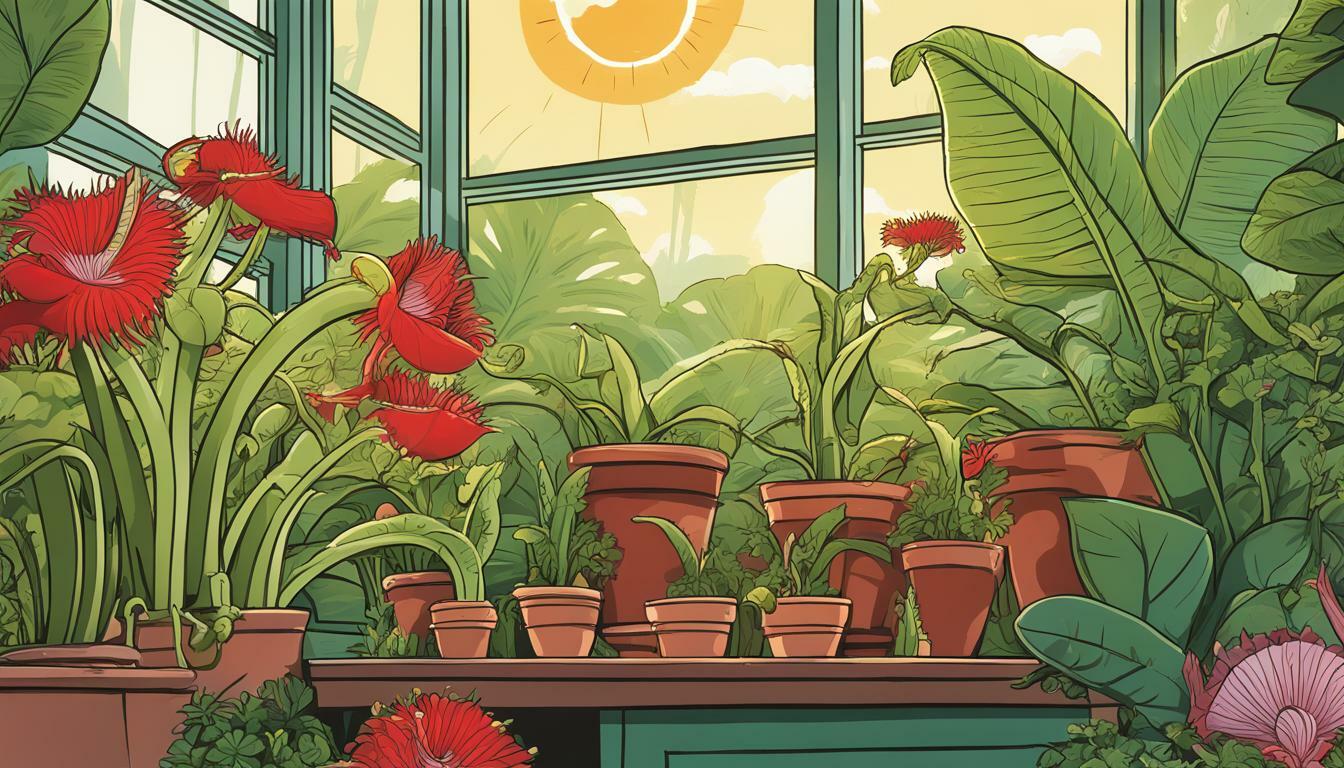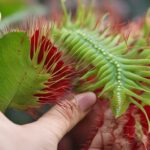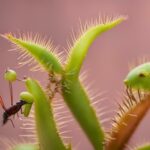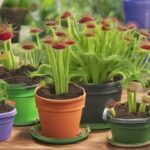If you’re a plant enthusiast, you’ve probably heard of the Venus flytrap. This fascinating plant has the ability to catch insects with its leaves, making it truly unique. However, keeping a Venus flytrap alive can be a challenge if you’re not familiar with its care requirements.
This article will provide you with essential tips for keeping your Venus flytrap healthy and thriving. You’ll learn about the basics of Venus flytrap care, how to feed your plant, and how to provide dormancy during the winter months. In addition, we’ll discuss common mistakes to avoid and troubleshooting tips for common issues.
Key Takeaways:
- Understanding Venus flytrap care is essential to keeping your plant alive.
- Proper sunlight, temperature, humidity, soil, and watering are all vital factors to consider when caring for your plant.
- Feeding your Venus flytrap with insects is necessary to ensure its proper nutrition.
- Providing dormancy during the winter months is critical for your plant’s survival.
- Avoid overfeeding, using inappropriate soil, and other common mistakes to keep your plant healthy.
- Troubleshooting common issues, such as yellowing leaves, fungus, and pests, will help you maintain a healthy plant.
The Basics of Venus Flytrap Care
Venus flytraps are unique and fascinating plants that require some special care to keep them healthy. If you’re wondering how to care for a Venus flytrap, here are some tips that will help you keep your plant healthy and happy.
Sunlight
Venus flytraps require plenty of sunlight to thrive. They should be kept in a sunny spot, preferably in a south-facing window that receives direct sunlight for at least 4-6 hours per day.
Temperature and Humidity
Venus flytraps prefer warm temperatures between 70-85°F during the day, and slightly cooler temperatures at night. They also like high humidity levels between 50-70%, which can be achieved by placing a tray of water near the plant or using a humidifier.
Soil Type
Venus flytraps require acidic soil that is low in minerals. A good soil mix for Venus flytraps is a combination of peat moss and perlite or sand. Avoid using regular potting soil or soil that contains fertilizer, as these can harm your plant.
Watering
Venus flytraps require moist soil, but they should never be allowed to sit in standing water. Water your plant with distilled water or rainwater to avoid mineral buildup in the soil. During the growing season, water your plant regularly to keep the soil moist, but not waterlogged.
By following these Venus flytrap care tips, you can ensure that your plant stays healthy and beautiful for years to come.
Feeding Your Venus Flytrap
Feeding your Venus flytrap is an essential part of its care. Since these plants thrive on insects, it is important to provide them with proper nutrition to keep them healthy and alive.
Firstly, it is essential to avoid feeding your flytrap any small bugs that aren’t insects, as they will provide little or no nutritional value. Your Venus flytrap will consume insects such as flies, spiders, and beetles, among others.
Secondly, it is important to avoid overfeeding your Venus flytrap. While it may be tempting to feed it often, too much food can damage the plant. Feeding your flytrap once every one to two weeks is sufficient.
Here’s how to feed your Venus flytrap:
- Use tweezers or a moistened toothpick to gently hold the insect.
- Place the insect inside the trap, making sure it touches the trigger hairs.
- Wait for the trap to close before removing your tweezers or toothpick to avoid injuring the trap.
- After several hours, the trap will open, and the insect will be consumed.
It’s important to avoid triggering the trap more than once, as this can exhaust the plant and reduce its overall health.
Remember, a Venus Flytrap can capture its own food if it’s kept properly. But, if it’s indoors, you can feed it small insects (like crickets) that you can purchase from a pet food store.
Providing Dormancy
During the winter months, it’s essential to provide dormancy for your Venus flytrap to ensure optimal health. By inducing dormancy, you’ll help the plant conserve energy and prepare for the upcoming growing season.
Begin by reducing watering, as your Venus flytrap will need less moisture during dormancy. However, make sure to keep the soil moist to prevent it from drying out completely.
In addition, you’ll need to provide cooler temperatures for your Venus flytrap. Ideally, the plant should be kept at a temperature of 45-50°F. If you live in a warmer climate, you can achieve this by placing your plant in a refrigerator or a cool, dark space such as a basement or garage.
It’s important not to fertilize your Venus flytrap during dormancy, as this can harm the plant’s delicate root system. Instead, focus on giving your plant the appropriate amount of light, moisture, and temperature to allow it to rest and prepare for the upcoming growing season.
Common Mistakes to Avoid
Keeping a Venus flytrap alive can be challenging, especially if you’re new to caring for these unique plants. Here are some common mistakes to avoid:
- Overfeeding: While Venus flytraps do need insects to survive, it’s important not to overfeed them. Feeding them too often can lead to rot, which can kill the plant.
- Using inappropriate soil: Venus flytraps need soil that is low in nutrients and retains moisture well. Using regular potting soil or soil with fertilizers can harm the plant.
- Not providing enough light: Venus flytraps need plenty of sunlight to thrive. Make sure your plant gets at least four hours of direct sunlight each day.
- Using tap water: Venus flytraps are sensitive to minerals and chemicals found in tap water. Use distilled or rainwater instead.
By avoiding these common mistakes, you’ll be on your way to providing your Venus flytrap with the care it needs to survive and thrive.
Troubleshooting Common Issues
Despite your best efforts, Venus flytraps can sometimes develop issues that require attention. Here are some common problems and how to solve them:
Yellowing leaves:
If your Venus flytrap’s leaves turn yellow, it may be due to too much or too little water. Make sure the soil is moist but not waterlogged, and reduce watering if necessary. Yellowing leaves can also be a sign of pests or fungal infections.
Fungus:
Venus flytraps are susceptible to fungal infections, which can cause spotting or discoloration of the leaves. To prevent fungus, make sure the soil is well-draining and avoid overwatering. If your plant does get infected, remove affected leaves and treat with a fungicide.
Pests:
Common pests that can affect Venus flytraps include aphids, spider mites, and scale insects. Remove any visible pests by hand and treat with an insecticide. Avoid using any sprays that contain oils, as they can damage the plant.
Drooping leaves:
If your Venus flytrap’s leaves are drooping, it may be due to lack of sunlight or inadequate feeding. Make sure your plant is getting enough light and feed it regularly with insects to ensure proper nutrition.
Deformed leaves:
If your Venus flytrap’s leaves are deformed or misshapen, it may be due to inadequate light or improper soil. Make sure your plant is getting enough light and that the soil is well-draining and appropriate for Venus flytraps.
By addressing these common issues promptly, you can ensure your Venus flytrap stays healthy and thrives in your care.
Conclusion
Caring for a Venus flytrap may seem daunting, but with the right knowledge and effort, you can keep these fascinating plants alive and healthy.
Remember to provide appropriate sunlight, temperature, and humidity. Use the correct soil and watering techniques, and feed your Venus flytrap with the right insects. Induce dormancy during the winter months and avoid common mistakes such as overfeeding and using unsuitable soil.
Takeaways for Venus Flytrap Care
Overall, Venus flytrap care requires attention to detail, but the rewards are worth it. Your Venus flytrap will thrive if you follow these survival tips:
- Provide bright light and warmth, but not direct sunlight.
- Use well-draining, acidic soil.
- Maintain constant humidity.
- Water your plant with distilled water or rainwater.
- Feed your Venus flytrap once or twice a month with live bugs.
- Induce dormancy by reducing watering and placing it in a cooler area for 3-4 months.
- Avoid common mistakes such as overfeeding, using unsuitable soil, and disturbing the trap mechanism.
By following these tips, you can enjoy the unique beauty of a Venus flytrap in your garden. So go ahead and give it a try – your Venus flytrap will thank you for it!
What Are the Care Requirements for Different Varieties of Venus Flytraps to Keep Them Alive?
The care requirements for different varieties of venus flytraps are crucial in ensuring their survival. These unique carnivorous plants need specific conditions to thrive, including a sunny location, well-draining soil, and distilled water. Additionally, they require a dormancy period during winter. Adequate research on the specific needs of different varieties of Venus Flytraps is essential for their long-term health.
FAQ
Q: Can you keep a Venus flytrap alive?
A: Yes, with proper care and attention, you can keep a Venus flytrap alive.
Q: What are the basics of Venus flytrap care?
A: The basics of Venus flytrap care include providing adequate sunlight, maintaining the right temperature and humidity, using the appropriate soil, and watering correctly.
Q: How do you feed a Venus flytrap?
A: To feed a Venus flytrap, you can use insects such as flies or small spiders. Place the insect on the trap and let the plant capture it. Avoid overfeeding and only use live insects.
Q: How do you provide dormancy for a Venus flytrap?
A: During the winter months, you can induce dormancy in a Venus flytrap by reducing watering and exposing it to cooler temperatures.
Q: What are common mistakes to avoid when caring for a Venus flytrap?
A: Common mistakes to avoid include overfeeding, using the wrong soil type, exposing the plant to extreme temperatures, and using tap water that contains chemicals.
Q: What are some common issues that can arise when caring for a Venus flytrap?
A: Common issues include yellowing leaves, fungal infections, and pest infestations. Proper troubleshooting techniques can help address these problems.











